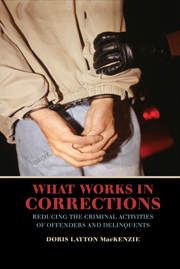Book contents
- Frontmatter
- Contents
- Acknowledgments
- PART ONE STRATEGIES FOR REDUCING CRIME
- PART TWO THE EFFECTIVENESS OF REHABILITATION PROGRAMS
- PART THREE TARGETING SPECIFIC TYPES OF OFFENDERS
- PART FOUR MANAGEMENT AND TREATMENT OF SUBSTANCE ABUSERS
- 11 Drug Courts: A Strategy for Managing Drug-Involved Offenders
- 12 Drug Treatment Programs for Offenders
- PART FIVE CONTROL, DISCIPLINE, AND PUNISHMENT
- PART SIX CONCLUSIONS
- References
- Index
- CAMBRIDGE STUDIES IN CRIMINOLOGY
11 - Drug Courts: A Strategy for Managing Drug-Involved Offenders
Published online by Cambridge University Press: 27 July 2009
- Frontmatter
- Contents
- Acknowledgments
- PART ONE STRATEGIES FOR REDUCING CRIME
- PART TWO THE EFFECTIVENESS OF REHABILITATION PROGRAMS
- PART THREE TARGETING SPECIFIC TYPES OF OFFENDERS
- PART FOUR MANAGEMENT AND TREATMENT OF SUBSTANCE ABUSERS
- 11 Drug Courts: A Strategy for Managing Drug-Involved Offenders
- 12 Drug Treatment Programs for Offenders
- PART FIVE CONTROL, DISCIPLINE, AND PUNISHMENT
- PART SIX CONCLUSIONS
- References
- Index
- CAMBRIDGE STUDIES IN CRIMINOLOGY
Summary
INTRODUCTION
Drug courts are a management strategy designed to use the authority of the courts to reduce crime by changing defendants' drug-using behavior. Drug-involved defendants are diverted to drug courts in exchange for the possibility of dismissed charges or reduced sentences. Judges preside over drug court proceedings and monitor the progress of the defendants. Working in collaboration with prosecutors, defense attorneys, treatment providers, probation agents, and others, judges proscribe sanctions for noncompliance with program requirements and rewards for compliance.
In comparison to traditional courtrooms, the drug court model is less punitive and more healing and restorative in nature. Courtroom procedures are more informal. Direct exchanges between the participant and the judge are common, and interactions between the state and defense are nonadversarial. A new working relationship occurs between the criminal court and health and treatment systems (Goldkamp, 1999). The role of the judge galvanizes the treatment process into a more powerful and accountable form of rehabilitation than previously available in the criminal justice system. The focus is not on the disposition of criminal cases but instead on rehabilitating drug-involved offenders.
The major goals of most drug courts are to reduce drug use and criminal activity. These goals are accomplished by engaging and retaining drug-involved offenders in supervision and treatment programs. Expertise about drug cases is concentrated in a single courtroom. Advocates of the drug courts argue that use of one courtroom increases the effectiveness of both clinical assessment of defendants' needs and case management.
- Type
- Chapter
- Information
- What Works in CorrectionsReducing the Criminal Activities of Offenders and Deliquents, pp. 221 - 240Publisher: Cambridge University PressPrint publication year: 2006



